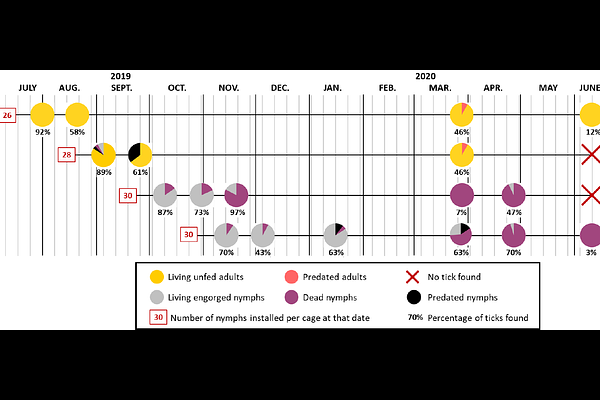Phenology of Hyalomma marginatum in a site in southern French

Phenology of Hyalomma marginatum in a site in southern French
STACHURSKI, F.; DUHAYON, M.; Appelgren, A.; BALANCA, G.; POLLET, T.; Vial, L.
AbstractHyalomma marginatum tick establishment has been recorded in southern mainland France for around ten years. This two-host species is one of the main vectors of the Crimean-Congo haemorrhagic fever (CCHF) virus. Knowing the phenology of the tick is a prerequisite for a better understanding of its spread and of CCHF virus dispersal. A six-year study was carried out in a horse herd to determine the seasonal variations of H. marginatum infestation. Adult ticks started infesting their hosts from the beginning of March. Infestation peaked during the first weeks of May and then steadily decreased until the end of August. This represented an average annual infestation of more than 300 H. marginatum per horse. Birds are parasitised by H. marginatum immatures (larvae and nymphs) in summer, between mid/late June to the end of September. The larvae are therefore not yet active when the migratory birds pass through in spring. Blackbirds, Turdus merula, were the most infested species: sixty percent of those examined in summer were parasitised by H. marginatum. This bird species could be a good sentinel host for monitoring the establishment of the species in currently H. marginatum-free areas. To complete this multi-year survey, an experimental study was carried out in quasi-natural conditions, with engorged ticks placed in cages in the garrigue. It was shown that the nymphs moulted into adults within 3-4 weeks in July-August. However, they remain completely immobile in the litter, undergoing a behavioural diapause, until the following spring. On the other hand, almost all the nymphs deposited later, in September or October, died during the cold and rainy season. It was also observed that engorged females are able to survive the cold conditions up to 6-8 months before laying eggs. The study also suggested that there were predators of H. marginatum, likely ants and spiders, in the study area. The hosts monitored over all these years were not only infested by H. marginatum. The phenology of other tick species parasitizing horses (Dermacentor marginatus, Haemaphysalis punctata, Rhipicephalus bursa) and birds (Ixodes frontalis, I. ricinus, Hae. punctata) was also highlighted for this study area.